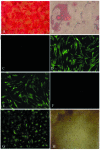Therapeutic effect of human umbilical cord mesenchymal stem cells modified by angiotensin-converting enzyme 2 gene on bleomycin-induced lung fibrosis injury
- PMID: 25435005
- PMCID: PMC4337478
- DOI: 10.3892/mmr.2014.3025
Therapeutic effect of human umbilical cord mesenchymal stem cells modified by angiotensin-converting enzyme 2 gene on bleomycin-induced lung fibrosis injury
Abstract
The aim of the present study was to evaluate the therapeutic effects of human umbilical cord mesenchymal stem cells (uMSCs) in the presence of angiotensin‑converting enzyme 2 gene (ACE2; ACE2‑uMSCs) on bleomycin (BLM)‑induced lung injury and pulmonary fibrosis in mice. A total of 100 male C57BL/6 mice were divided at random into five groups (n=20) as follows: Control group, BLM group, ACE2 group, uMSC group and ACE2‑uMSC group. At 7, 14 and 28 days post‑treatment, the following parameters were evaluated in lung tissue: Oxidation indexes [malondialedehyde (MDA), superoxide dismutase (SOD), glutathione (GSH) and oxidized glutathione (GSSG)]; fibrosis factors [tumor necrosis factor (TNF)‑α, interferon (IFN)‑γ and transforming growth factor (TGF)‑β]; inflammatory cytokines [Interleukin (IL)‑1, IL‑2, IL‑6 and IL‑10]; ACE2 gene expression; hydroxyproline and collagen type 1 messenger RNA (mRNA) concentration; as well as matrix metalloproteinase (MMPs; 2 and 9) and tissue inhibitor of metalloproteinase (TIMP)1‑4 expression. ACE2‑uMSC injection following bleomycin pretreatment significantly alleviated lung injury in mice. In addition, treatment with ACE2‑uMSCs demonstrated a stronger therapeutic effect than ACE2‑ or uMSC treatment alone, indicated by decreased expression of MDA, GSSG, TNF‑α, IFN‑γ, TGF‑β, IL‑1, IL‑2, IL‑6, collagen type 1 mRNA, MMPs and TIMPs as well as hydroxyproline concentration, and upregulation of SOD, GSH and ACE2 and IL‑10. In conclusion, the results of the present study demonstrated that ACE2 and uMSCs had a synergistic therapeutic effect on bleomycin‑induced acute lung injury.
Figures







Similar articles
-
Human umbilical cord mesenchymal stem cells reduce fibrosis of bleomycin-induced lung injury.Am J Pathol. 2009 Jul;175(1):303-13. doi: 10.2353/ajpath.2009.080629. Epub 2009 Jun 4. Am J Pathol. 2009. PMID: 19497992 Free PMC article.
-
Inhibition of bleomycin-induced pulmonary fibrosis by bone marrow-derived mesenchymal stem cells might be mediated by decreasing MMP9, TIMP-1, INF-γ and TGF-β.Cell Biochem Funct. 2015 Aug;33(6):356-66. doi: 10.1002/cbf.3118. Epub 2015 Jul 15. Cell Biochem Funct. 2015. PMID: 26178702
-
Combination therapy with human umbilical cord mesenchymal stem cells and angiotensin-converting enzyme 2 is superior for the treatment of acute lung ischemia-reperfusion injury in rats.Cell Biochem Funct. 2015 Apr;33(3):113-20. doi: 10.1002/cbf.3092. Epub 2015 Mar 10. Cell Biochem Funct. 2015. PMID: 25756848
-
Mesenchymal stem cells modulate lung injury.Proc Am Thorac Soc. 2010 May;7(2):130-3. doi: 10.1513/pats.200908-091RM. Proc Am Thorac Soc. 2010. PMID: 20427585 Free PMC article. Review.
-
Cell Therapy of Corneal Diseases.Cornea. 2016 Nov;35 Suppl 1(Suppl 1):S9-S19. doi: 10.1097/ICO.0000000000001010. Cornea. 2016. PMID: 27631350 Free PMC article. Review.
Cited by
-
Genetically Modified Mesenchymal Stromal/Stem Cells: Application in Critical Illness.Stem Cell Rev Rep. 2020 Oct;16(5):812-827. doi: 10.1007/s12015-020-10000-1. Stem Cell Rev Rep. 2020. PMID: 32671645 Free PMC article. Review.
-
Mesenchymal stromal cells as treatment for acute respiratory distress syndrome. Case Reports following hematopoietic cell transplantation and a review.Front Immunol. 2022 Nov 8;13:963445. doi: 10.3389/fimmu.2022.963445. eCollection 2022. Front Immunol. 2022. PMID: 36426365 Free PMC article. Review.
-
An overview of the recent findings of cell-based therapies for the treatment and management of COVID-19.Int Immunopharmacol. 2021 Dec;101(Pt B):108226. doi: 10.1016/j.intimp.2021.108226. Epub 2021 Oct 6. Int Immunopharmacol. 2021. PMID: 34634685 Free PMC article. Review.
-
Human umbilical cord mesenchymal stem cells and exosomes: bioactive ways of tissue injury repair.Am J Transl Res. 2019 Mar 15;11(3):1230-1240. eCollection 2019. Am J Transl Res. 2019. PMID: 30972158 Free PMC article. Review.
-
Review of Trials Currently Testing Stem Cells for Treatment of Respiratory Diseases: Facts Known to Date and Possible Applications to COVID-19.Stem Cell Rev Rep. 2021 Feb;17(1):44-55. doi: 10.1007/s12015-020-10033-6. Stem Cell Rev Rep. 2021. PMID: 32827081 Free PMC article. Review.
References
-
- Kumar P, Goldstraw P, Yamada K, et al. Pulmonary fibrosis and lung cancer: risk and benefit analysis of pulmonary resection. J Thorac Cardiovasc Surq. 2003;125:1231–1237. - PubMed
MeSH terms
Substances
LinkOut - more resources
Full Text Sources
Other Literature Sources
Research Materials
Miscellaneous

